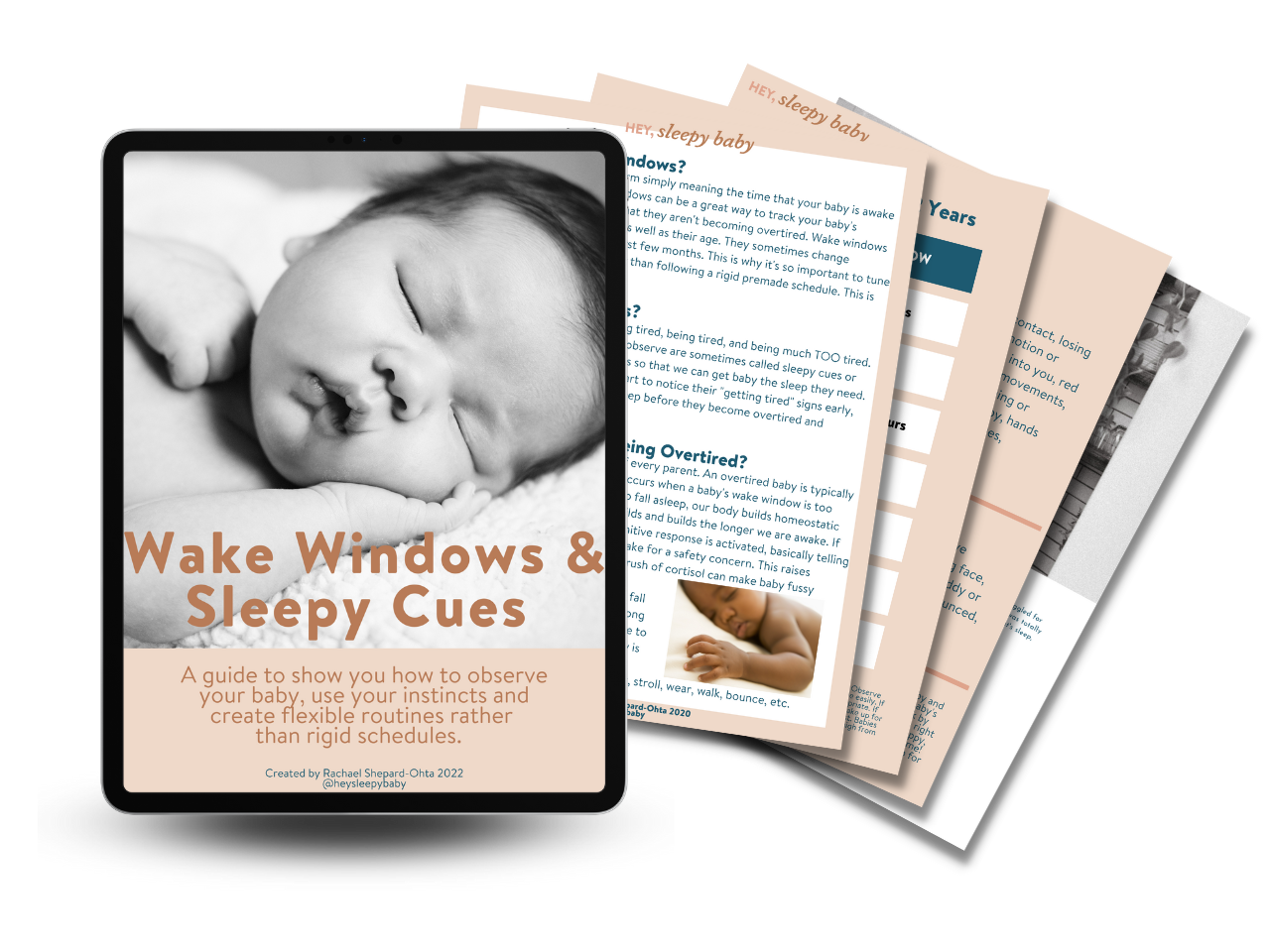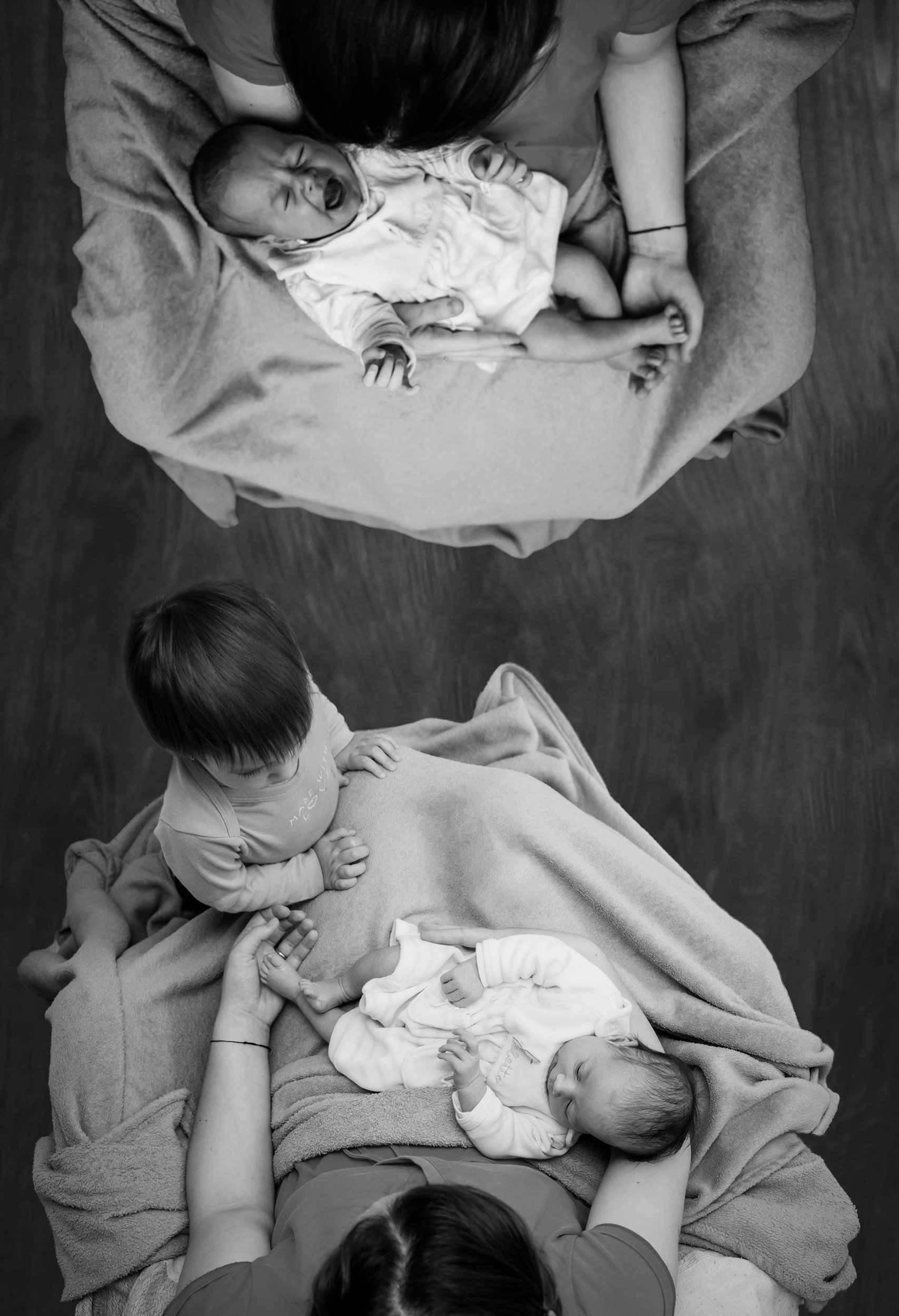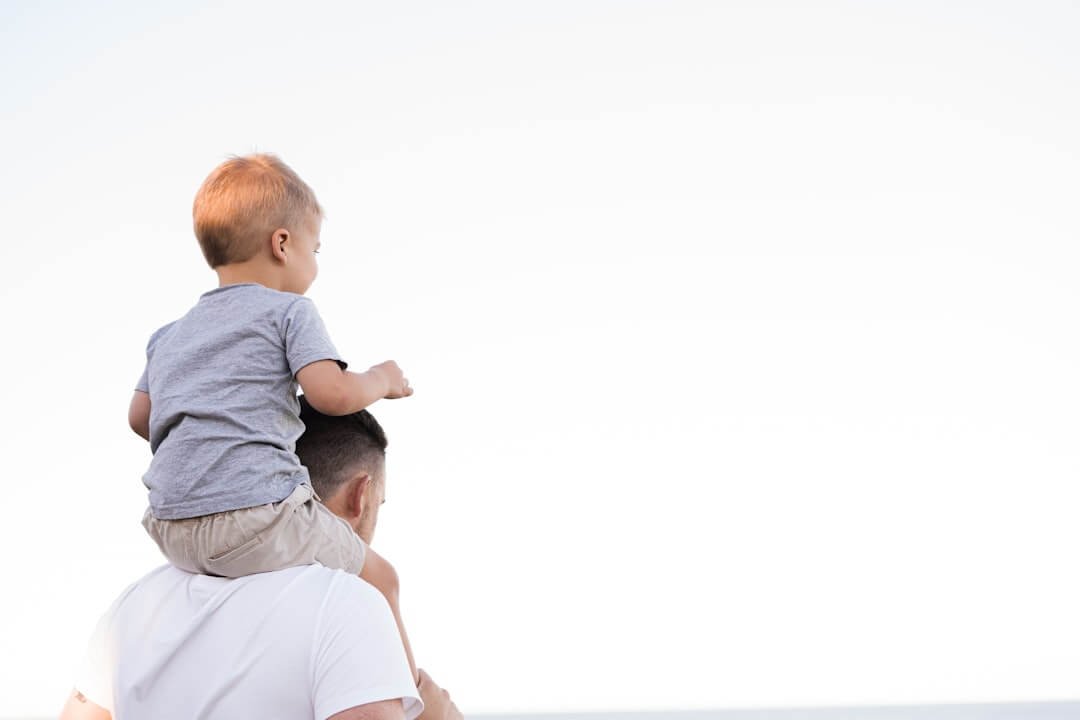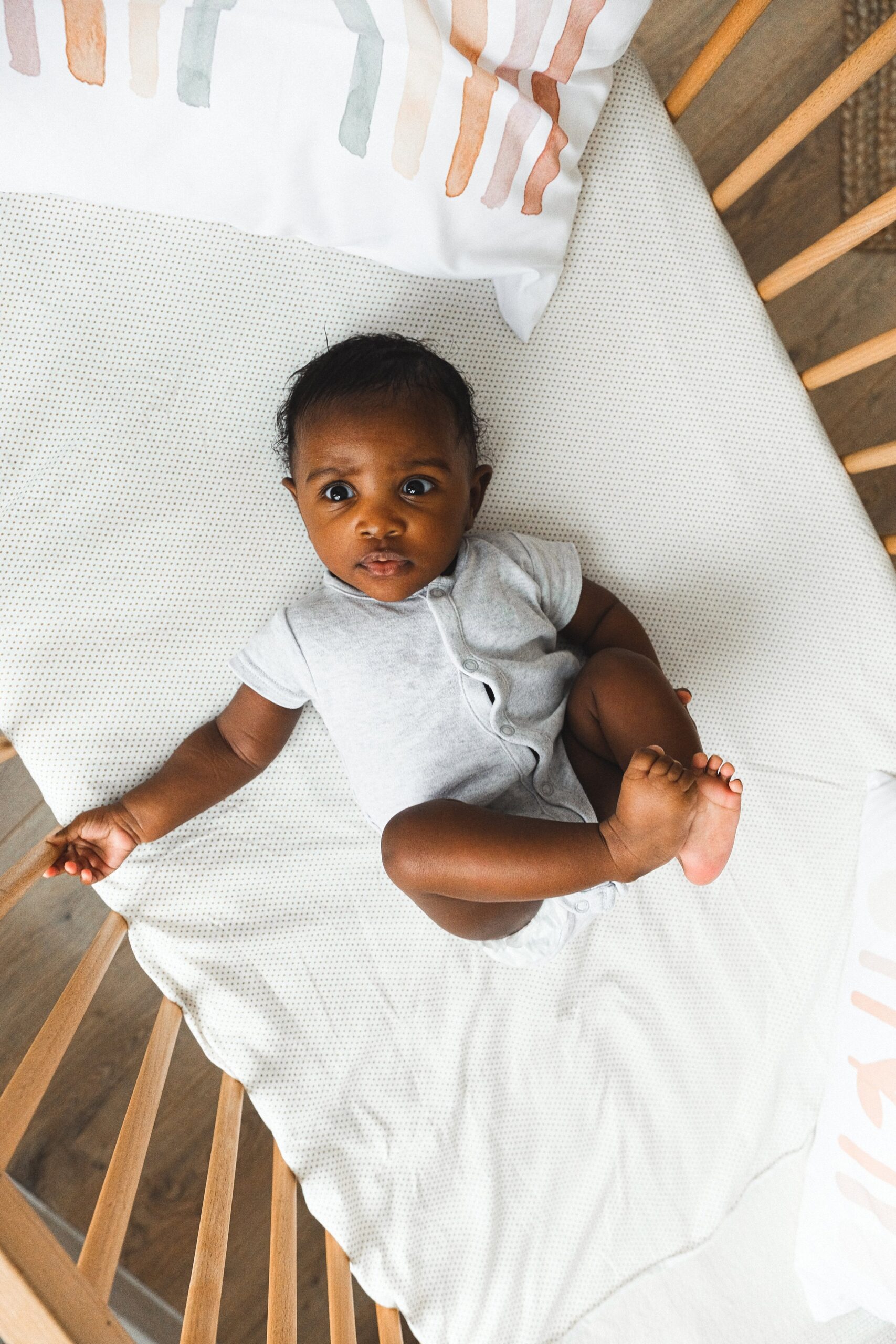I'm Rachael
Mom of 3 & Baby Sleep Expert with Big Sis Energy
& I’VE DONE ALL THE RESEARCH FOR YOU ALREADY.
Better sleep for the entire family
BROWSE COURSES
hey!
wake windows for babies: are wake windows evidence based?
April 26, 2024
in this post:
If you’ve had a baby recently you’ve surely heard of “wake windows” by now. But what are they? And are wake windows actually important? Do we need to pay attention to them? Where do they even come from!? In this blog I’ll explain all about what wake windows are and where they originated from, whether or not they’re important to follow, and recommended wake windows by age.
.
What are “wake windows?”
The concept of “wake windows” in babies refers to the duration of time a baby can comfortably stay awake between naps or bedtime before becoming overtired. But there’s actually no direct research that looks at “wake windows” as a term or that tests wake windows specifically. Rather, the idea has been made up through a combination of work looking at average sleep totals for different age groups, effects of overtiredness, etc.
.
Do you need to follow wake windows with your baby?
So what does this mean for you? Do you need to follow wake windows or not? Well- it’s up to you! Wake windows definitely ARE a thing- while the term is made up, the idea behind it can be very helpful for families. Many of us have NO CLUE how short of a time young babies can actually stay awake for when we first become parents. For this reason, using wake windows as a guide can be incredibly helpful for lots of us when we are getting to know our babies! For some, wake windows are a great starting point to loosely follow for the first few weeks or months. On the other hand, wake windows are essentially made up and can vary by as much as a couple of hours depending on the chart you find. For this reason, it’s best to ditch the idea of “ideal” or “perfect” wake windows for a particular age. Each baby is so unique and their sleep needs can be different by up to several hours even if they are the exact same age.
So what do I recommend? Use wake windows as ONE tool, paired with learning your child’s sleepy cues and working with their circadian rhythm. You may use a chart as a starting place, but observe YOUR baby to figure out THEIR ideal wake windows, nap times, and bedtime.
All of this being said, following wake windows is absolutely optional. Like most things with baby sleep and parenting, no ONE tool works across the board for everyone. Following wake windows may be too anxiety producing or simply impossible for your family- and that’s absolutely OK! Permission to ditch them completely if they don’t serve you.
.
When do you stop using wake windows?
People often ask when they can STOP using wake windows (if they are going to follow them with their babies in the first place). It really depends! Most parents we work with use some form of “wake windows” even if it’s very loose and informal to track how long baby has been awake for and when they may be getting sleepy. It’s usually helpful to use WW’s as a guide as long as your little one is taking multiple naps per day. Once they drop down to 1 nap per day around lunchtime, wake windows aren’t as necessary. You may still use them to calculate when the nap should happen or when bedtime should be depending on how long they sleep, but it’s not as crucial.
Some parents find that the temperament of their little one is very regular, like a clock. These babies are the ones who are very predictable, like naps and bedtime to always be the same, and thrive on schedules and routines. For these types, wake windows might work great throughout infancy and even toddlerhood. Other kids are more go-with-the-flow types who resist schedules. Some families find it impossible to follow regular wake windows because of work or childcare schedules, other children in the house, etc. That’s also ok and not a reason to panic. Nothing bad will happen to your child if you aren’t following wake windows perfectly. Heck- they don’t even WORK for a large percentage of the population! So here’s your permission to use them if you want to but ditch the whole idea if you find it more stressful than helpful.
TIP: Wake windows increase as baby gets older. Around every 3-4 weeks, think about extending your little one’s wake time by 15-20 minutes or so. You can also try extending wake windows any time you notice it taking a looooong time for your baby to fall asleep, or if they start taking very short naps but are waking up content and ready to go. This could be a sign that they simply didn’t have enough “sleep pressure” or awake time before that nap!
.
So what are the wake windows for my baby?
Wake windows are really just an AVERAGE to be used as a guide- not an exact science! I’ve determined my recommended age-appropriate windows by looking at a wide range of data on sleep totals, nap lengths, etc. in infancy plus anecdotally from work with our clients. Remember that these are HUGE windows so it’s really key to observe your baby and tune into their “sleepy cues” to use in partnership with WW’s. Here are the wake windows we recommend:

.
so what are the sleepy cues to look for?
Remember that wake windows are simply ONE tool in your toolbox, and they aren’t right for everyone. Some babies are high sleep needs and others are low sleep needs, and these charts are likely to drive those parents nuts! That’s why it’s best to be aware of wake windows but to observe YOUR baby to figure out their ideal schedule. There are “early” sleepy cues and “late” sleepy cues.
For newborns and younger babies, the biggest one I want you to look for is the “stare.” This is when your baby breaks eye contact with you, stares into space, or seems to want a break from looking at you or their toy. They might also have eyes that are glossy, or slightly reddened eyebrows. These are the tell-tale signs of a baby who is getting ready for a nap, and I’d start your routine when I see this. Some other earlier sleepy cues include getting quiet or slowed movement.
As for the late cues? Those are a little more obvious- things like red eyes, rubbing, nuzzling, or clinging to you, fussiness, having a very difficult time settling down etc. These are signs that your little one may have missed their ideal “window.” If this happens, it’s OK! It happens to all of us. This is why it can be so helpful to keep track of your baby’s wake time to figure out THEIR ideal “wake window.” If you’re noticing these cues happening if they stay up for 1.5 hours but they’re still OK at 1 hour, try starting their routine around that hour mark to have them asleep sooner.
Need more help with this?
If you’re still confused about using wake windows and sleepy cues, that’s OK! It’s a lot, I know. I’ve created a FREE printable for you that breaks it all down and gives you some handy charts you can print off and hang on the fridge, share with grandma, etc! Click here to download your free guide. You can always check out our Newborn Masterclass to find out everything you need to know about baby sleep in those first
found this helpful? save for later!
Featured
When daylight saving time ends, we “fall back” one hour, meaning that sunrise and sunset will occur an hour earlier. How will this affect your baby’s sleep?
Responsive sleep tips and support for parents of multiples or twins.
What are floor beds? When to use them? And How to use them?
binge reads
We think you'll love these
You deserve to the
baby stage, not just "survive it."
And you DON'T have to sacrifice your values, ignore your instincts, or force yourself to follow a method you don't align with just to get your baby back to sleep.
I’m here to help you create a restful, sustainable sleep environment that honors both your baby’s needs AND your own (without the stress OR the guilt!) because, no, you don’t have to choose between the two.
enjoy!
BABY SLEEP COURSES →
BABY SLEEP CONSULTS →
Wish you could help your baby sleep better without resorting to sleep training? Download my FREE guide to a good night’s sleep and learn 8 simple, science-backed tips for supporting your child’s needs.
Traditional sleep training methods don’t have to be your solution to better sleep.
SLEEP TRAINING ISN’T THE ONLY WAY TO GET GOOD SLEEP
Hey, I'm Rachael and Hey, Sleepy Baby is for parents who want to get their nights back, without sleep training their babies.
NO ONE TOLD US POD
explorING the untold truths of parenting







